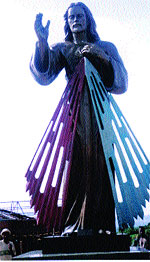 |
 |
|||||
 |
 |
 |
 |
 |
|||
 |
Mercy finds a home
Statue from Chicago now graces a wounded Rwanda parish By Raymond Cleaveland An 18-foot bronze statue of the Divine Mercy Jesus that once toured Chicago parishes has a new home in Rwanda, the African nation still reeling from a horrible genocide. The statue, a gift from St. Stanislaus Kostka Parish, arrived on the 10th anniversary of the Rwandan genocide, in which 1 million people were slaughtered. “Chicago Catholics have brought this war-torn city peace and consolation,” said Resurrection Father Anthony Bus, pastor of the Northwest Side parish. The three-ton Divine Mercy statue was dedicated June 25, 2000. Parishioner Oscar Delgado, 41, commissioned the statue from an artist in Mexico. Ïith the help of a large crane from Taft Contracting Co., the statue toured archdiocesan parishes for the next two years. Bus said it has been a source of many graces and spiritual healings for his parish. It should not be an unhappy event that the Divine Mercy statue that once graced Chicago is now in Rwanda. For 40 years, tensions between rival Tutsi and Hutu tribes grew more and more tense. On April 6, 1994, Hutu President Juvenal Habyarimana was assassinated and thousands of Hutu militiamen surrounded Kibeho, a town 60 miles south of the capital, Kigali. More than 5,000 of Kibeho’s Tutsi civilians, many of them children, took refuge in a church which was destroyed. The massacre spread throughout Rwanda and left more than one million dead, more than 25,000 in Kibeho alone. “The people have suffered unimaginable pain,” said Bus. “The horrors of the genocide are beyond human comprehension.” It was growth in the devotion to the Divine Mercy of Jesus that led to the statue’s move. As more worshippers began praying the devotion growing, popularized by St. Faustina Kowalska, who was canonized by Pope John Paul II in 2000, Bu? decided to build a shrine on the parish grounds in honor of the Divine Mercy. While the statue which now stands in Kibeho was a religious landmark for commuters on the Kennedy Expressway, Bu? realized as he planned the shrine last year that the 18-foot sculpture was too big. That’s how the idea of giving it away came about. Bu? said he prayed about where it should go. “We wanted to do it in a way that would be in accord with God’s will,” he said. Bu? has undertaken a marathon prayer regimen at the parish. He says he spends every afternoon from 3 to 8 p.m. hearing confessions, leading a holy hour with Eucharistic adoration and benediction and directing the rosary and Divine Mercy chaplets. He finishes his day with the celebration of evening Mass. Delgado and other parishioners were also part of the discernment process. “I said to Our Lady, ‘This is your present, so you tell me where you want it,’” recalled Delgado. A missionary priest who heard about the statue suggested to Bu? that it be sent to the Rwanda’s Shrine of Our Lady of Kibeho, the site of several Marian apparitions in the 1980s. The Vatican approved these apparitions in 2001. Bu? and the parishioners met the idea with a resounding “yes.” Parishioner Geralyn Sullivan, 43, of Chicago, said she misses the statue but notes the great attraction of the budding shrine. “People come from all over, and many bring their friends,” she said. Sullivan said she thought Kibeho was the right choice. “I think that it’s a special place given everything that’s happened, especially the genocide,” she said. In November, Bu? and Delgado traveled to Kibeho to deliver and dedicate the Divine Mercy statue. It was erected atop Kibeho’s Hill of God, where more than 1,000 people attended the Mass and dedication on the feast of Christ the King. “It’s a very sturdy, strong, permanent symbol that God is present even in the midst of their own sorrows and will not abandon them,” said Bu?. Delgado saw the great sense of wonder among the people. “You can see in their eyes,” he said. “They were in amazement that we would give a gift like that. They really don’t understand why people would want to help them,” Delgado added. Bu? agreed. “You could see it in their faces. They danced and sung as an expression of gratitude. Their eyes spoke volumes of their gratitude and consolation,” he said. The statue may be the first step in a long process of healing. “It’s hard to fathom such a beautiful country covered in blood, but it’s great that Chicago has played an instrumental role the healing of a country exactly 10 years after the genocide,” said Delgado. Bu? and the parishioners of St. Stanislaus plan to commission another statue for the shrine. In the meantime, Sullivan said, “Every time I drive by, I miss the statue, but it’s all in God’s plan, and hopefully it will come to fruition in God’s time.”
Bu? tells the story of the Divine Mercy shrine in his book, “A Mother’s Plea,” to be published by Marian Press in January. Donations for Kibeho can be sent to St. Stanislaus Kostka, Attention: Rwanda Mission. Cleaveland, a seminarian for the Archdiocese of Seattle, is studying at Mundelein Seminary.
|
||
|
|
|||